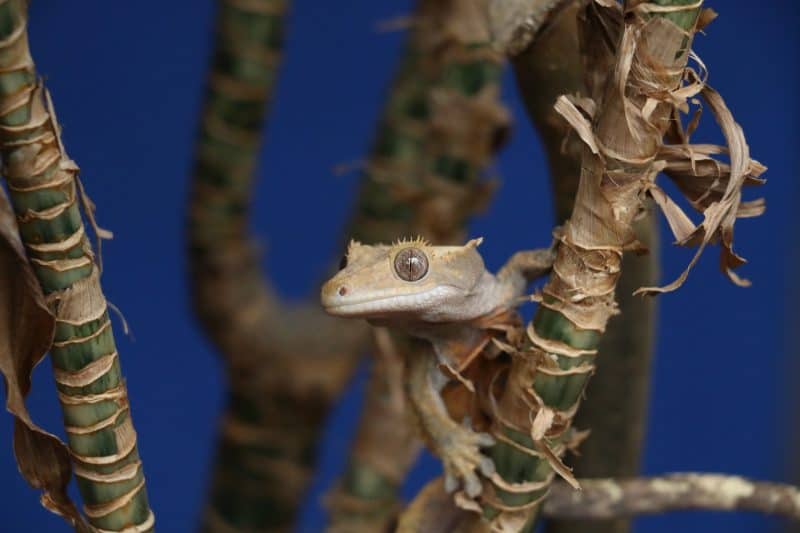Crested geckos are popular pets for a number of reasons. It’s easy to see why: They’re easy to feed, they have endearing personalities, and they are pretty affordable too.
But there is more: there’s an underappreciated reason crested geckos make fantastic captives… They can be kept in functional or natural-looking habitats.
This means that they are great for keepers and breeders who prefer to maintain spartan, “sterile” habitats, as well as those who want to set up a completely natural-looking terrarium, complete with live plants and other decorations.
However, no matter which type of enclosure you want to set up, you’ll need to satisfy your pet’s basic housing needs to keep him healthy. We’ll help you do exactly that below, as we walk you through everything you need to know to provide your pet with a top-notch habitat.
What Is the Crested Gecko’s Natural Habitat?
Crested geckos are native to New Caledonia and at least one off-shore island. The area is covered in dense tropical rainforest, which provides everything the lizards need to survive.
Temperatures in this region vary from about 71 to 75 degrees Fahrenheit, although they occasionally exceed 80 degrees during warm spells. Cold temperatures are quite rare in New Caledonia, although it does drop into the 50s on rare occasions.
Crested geckos appear to spend their days hiding amid dense vegetation in the cool understory. They become active as the sun sets, but they still tend to remain close to the ground, where the air is relatively cool.
Unlike many other tropical geckos, crested geckos do not appear to commonly colonize areas disturbed by human activity. Instead, they tend to remain in undisturbed areas.
The Crested Gecko Tank: What Type of Enclosure Should You Use?
There are a variety of different enclosures that will work for crested gecko maintenance. It is up to each individual keeper to decide which one best suits their own needs, as well as those of their pet.
However, every type of enclosure presents different benefits and drawbacks. You’ll want to consider these carefully before making your selection. We’ll explain a few of the enclosure types that usually work well for crested geckos below.
Aquaria
Glass aquaria are popular for two primary reasons: They’re readily available and they are relatively affordable. They also offer observers the chance to see the animal from multiple angles.
However, glass aquaria have a number of drawbacks. For starters, glass aquaria are very fragile; it’s easy to break them during the course of routine maintenance. Glass aquaria are also heavier than many new keepers would expect, and they are laborious to clean. But the most serious drawback to aquaria involves your pet’s wellbeing.
The very visibility that appeals to people viewing crested geckos inside glass aquaria often leads to stress for the lizards. Simply put, crested geckos don’t like feeling exposed to predators in the way glass aquaria make them feel. You can mitigate this problem by covering two or three sides of the tank, but that doesn’t solve the durability or weight issues.
Glass Reptile Enclosures
At first glance, it may be difficult to appreciate many consequential differences between glass aquaria and glass reptile enclosures. After all, they’re both glass boxes used to keep various types of critters. But while the differences between the two are subtle, they end up being quite consequential indeed.
One other problem with aquaria that wasn’t mentioned above is their opening – aquaria open from the top. Top-opening enclosures are helpful for maintaining some types of reptiles, but not arboreal geckos. When you open the top of a bearded dragon’s aquarium (for example), he will simply sit there and look at you. But if you open the lid to a skittish crested gecko’s tank, the lizard may leap for freedom and escape.
But most glass reptile enclosures have doors on the front, rather than the top (although many have both). Front-opening habitats are much better for keeping crested geckos, as the lizards will not tend to flee directly toward the opening. It is also usually easier to clean and maintain enclosures with doors placed on the front, rather than the top.
Many times, glass reptile enclosures are designed with dimensions that better suit reptiles, as opposed to fish. However, this isn’t as big a problem for crested gecko keepers as it is those who keep some other reptile species.
Nevertheless, while glass reptile enclosures are likely preferable to glass aquaria for most crested gecko keepers, they still aren’t perfect. Like aquaria, glass reptile enclosures are heavy and fragile, and they’re typically more expensive than aquaria of similar size.
Plastic Reptile Cages
Plastic reptile cages are often the enclosure type of choice for professional crested gecko breeders and advanced hobbyists. They typically cost more than most brand new keepers would like to spend, but they are likely the best option for those willing to make the investment.
Plastic reptile cages are usually much lighter than all-glass enclosures, and they are almost always more durable too. Because they’re specifically designed for reptiles, they usually come in effective shapes and sizes. Many even come with built-in bonuses, such as lamp shrouds and adjustable vents.
Most plastic reptile enclosures are opaque on five of their six sides, with only a single glass door through which you can see your pet. This does make it more challenging to observe your lizard, but it reduces the amount of time you’ll spend cleaning glass. It also tends to make geckos (and most other reptiles) feel more secure, and therefore, relaxed.
Plastic Storage Boxes
Plastic storage boxes are an underappreciated, but effective enclosure option for crested gecko keepers. They are much cheaper than any other enclosure option. This is not only great for your bank account, it means most keepers will be able to afford a very spacious habitat for their pet.
Plastic storage boxes are also lightweight and easy to clean. In fact, you can usually buy two habitats to make maintenance easier. Simply prepare a fresh habitat for your pet, move him from his dirty habitat and into his clean habitat, and then clean the dirty enclosure.
The primary drawback to plastic storage boxes is that they make it difficult to observe your pet. However, this will usually help ensure your lizard remains relaxed, which will help keep him healthy.
Additionally, it is possible to cut a large opening in one side of the box and glue a clear acrylic panel in its place. This will essentially create a viewing window that is as effective as the glass doors of plastic reptile cages.
> Further Reading: What Do Crested Geckos Eat?
Lighting: What Kind of Lights Do Crested Gecko Need?
Unlike green iguanas, bearded dragons and many other lizards commonly kept as pets, crested geckos do not require special lighting of any kind. The ambient room light will provide all of the illumination these lizards need. Remember, crested geckos typically inhabit the dim forest understory, they are quite accustomed to living in shaded areas.
In fact, many keepers will need to forego lighting to avoid overheating their crested gecko’s enclosure. However, if you decide to include live plants in the enclosure, or you just want to highlight your animal’s colors, you can install fluorescent lights above the habitat.
Just be sure to use a lamp timer if you install lights in the habitat. Set the timer to provide a 12-hour cycle, so that the lizards have nights and days of equal length.
Ideal Tank Temperature: The Heating Devices
Crested geckos prefer cooler temperatures than many other reptiles kept as pets. They generally prefer temperatures between 68- and 80-degrees Fahrenheit, and temperatures exceeding 82 will often cause them great stress.
Accordingly, most keepers don’t need to use any heating devices at all. Just be sure to purchase a high-quality digital thermometer so that you can monitor the temperatures and ensure your lizard’s health and safety.
If you do find it necessary to use supplemental heat sources for your crested gecko, it is usually wise to use low-powered devices. A standard heat lamp and shroud will work, and this will give you the chance to adjust the amount of heat provided by varying the bulb wattage used. Heat pads can also be effective for crested gecko maintenance.
Just be sure to place the heating device at one end of the habitat, rather than the center. This will help create a thermal gradient or range of temperatures. Your lizard can then move about the habitat as necessary to achieve the most comfortable body temperature possible.
What Is the Best Crested Gecko Substrate?
Crested gecko keepers use a variety of different substrates. A few of the most popular choices are discussed below.
- Orchid Bark – Orchid bark is one of the best substrates available for crested geckos. Orchid bark (which is actually made from the bark of fir trees) is safe for geckos, it looks great and it lasts for quite a while too. The only downside is its cost – orchid bark is likely the most expensive substrate in widespread use.
- Cypress Mulch – Cypress mulch doesn’t look quite as nice as orchid bark, and it tends to breakdown a little faster inside the habitat. However, it is safe and very affordable, so it is the go-to choice for many keepers. Cypress mulch also retains water very well, which helps to maintain a high enclosure humidity.
- Paper Towels – Paper towels are a good option for hatchling and quarantine enclosures, as they’re hygienic and easy to replace. You can dampen paper towels to increase the habitat humidity, and they don’t represent an ingestion hazard. However, paper towels certainly don’t look very nice, so they aren’t a good option for keepers who like elaborately decorated tanks.
- Newspaper – Newspaper is similar to paper towels, but it does differ in a few key ways. For starters, newspaper is more durable than paper towels, and it comes in much bigger sheets too. This makes it easier to use in large enclosures than paper towels. Additionally, you can often obtain newspaper for free or nearly so.
Newspaper is likely the most common substrate used by professional breeders, as it is simple, affordable and safe. It’s also easy to change on a daily basis, which helps ensure proper habitat hygiene. On the other hand, most amateur keepers and enthusiasts prefer using cypress mulch, as it looks much better than newspaper or paper towels.
Suitable Humidity in the Crested Gecko Terrarium
Because they hail from tropical rainforests, crested geckos require high humidity levels to thrive. Different keepers prefer to maintain slightly different humidity levels, but generally speaking, you’ll want to shoot for a relative humidity of 50% to 80%.
You can achieve high humidity levels by employing any of several different strategies. Some of the most effective include:
- Use a moisture-retaining substrate, such as cypress mulch. You’ll need to moisten the mulch regularly, but this water will then evaporate over time, thereby raising the habitat’s humidity level.
- Incorporate a large water dish. You only need to use a small dish to satisfy your gecko’s need for drinking water (and he may not use it anyway), but by using a larger water dish, you’ll raise the humidity in the habitat significantly.
- Reduce the amount of ventilation provided. You must always ensure that your lizard’s habitat experiences plenty of air exchange, but by partially covering vents or screened lids, you can reduce the amount of water that escapes the habitat.
- Increase the amount of water you spray into the enclosure. You will need to mist your gecko’s habitat on a daily basis to provide drinking water. But, if you need to raise the humidity level, you can simply increase the amount of water you spray into the tank each day.
It’s usually not very difficult to provide your pets with a high humidity level. Just be sure to keep the habitat clean, as damp conditions can cause bacteria and fungi to proliferate.
> Further Reading: The Crested Gecko Behavior & Health
Crested Gecko Supplies and Decor
Your crested gecko does not need an elaborately decorated enclosure to thrive. He will need plenty of things to climb and several hiding places, but he won’t care what these objects are. Many breeders and experienced keepers use things like paper towel tubes and pieces of egg crate to provide such opportunities.
However, you can decorate your crested gecko’s habitat if you like. For example, you could use real or fake branches to provide climbing opportunities. Cork bark slabs and tubes would work well in this context too. You can also incorporate live or artificial plants in the habitat, to help provide hiding places and create a rainforest-like environment.
In practice, you can add just about any type of decorations you like to your gecko’s enclosure. Just be sure that anything you select is safe and easy to clean.
Conclusion
Part of the reason crested geckos have become so popular is that it is easy to provide the kind of housing they need. Just be sure that you address all of the key issues discussed above and you’ll likely find it easy to create a fantastic habitat for your new pet.
We hope this article has helped you familiarize yourself with some of the most important aspects of crested gecko husbandry. If you’ve found it helpful, please share this article with your friends and family – particularly those who are interested in crested geckos.









9 Comments
Hi I have an 8 month old crestie and he is having a rough shed. He has some stuck on his feet and here recently his tail at base near spine has a curve to it. He walks weird now. Can barely jump. I feed him the powder crestie diet food plus calcium liquid added. Mealworms in occasions. I mist 2-3 times daily. What am I doing wrong ?
Hi D’anna,
You may not be doing anything wrong, but it could be that your crestie is having some issues with shedding. You should try to carefully remove the stuck shed with a Q-tip soaked in warm water, and then thoroughly mist your gecko with lukewarm water to help loosen the skin. If the stuck shed doesn’t come off easily, then you may need to give your crestie a lukewarm soak of 10-15 minutes to help loosen the skin.
Make sure the water is shallow enough for your gecko to keep its head above water. After soaking, try again to remove the stuck areas with a damp cotton swab or your fingers. Be sure to be very gentle and never pull or force the shed off, as this can cause injury.
Good luck!
So one of the things that I am struggling with, and having a hard time finding information for, is how to LOWER the temperature. I have a little crestie that we have had for a while now, and there has been no issues until recently with a HUGE temperature spike in my area. I have been able to get it lowered a little bit, but right now his enclosure is staying around 83. I have him in the coolest room in the house, out of sunlight, and no heating elements at all except the natural air. Please help!!!!! Also thank you so much! Your website has helped me with almost every pet I have owned 🙂
Hey, Krystal.
That’s a tough one, and the reason it’s hard to find information on cooling a habitat is because there just aren’t many easy ways to do so.
Unfortunately, it’s much simpler to warm something up than cool it down (in these types of applications). You already sound like you’re doing everything right, the only other thing you could do would be install a small air-condition unit to the room his habitat is in.
It may be that your living situation is just too warm for crestie maintenance.
Sorry I couldn’t offer more help!
Hey Krystal,
We had the same problem recently with these crazy heat waves and we found putting some ice packs on top our terrarrium and a fan next to the enclosure lowered the temp a few degrees. Hope it works!
I own a crested gecko and I am hoping to provide a habitat for my new pet. It’s good that you mentioned how plastic terrariums would be the best enclosure for geckos because it is solely designed for reptiles. When I buy one, I shall then follow your tip to maintain the suitable humidity in its terrarium for survival.
Hey, Victoria.
Plastic terraria are generally the best option, although glass enclosures will work too.
We wish you the best of luck!
Hi! I just got my daughter a crested gecko (which I’ve been around and handled her for a couple years. She belonged to a friend of mine) and we are SUPER excited!! We’ve named her Sunny. I have a couple questions..
1) Handling: We all like her and are super fascinated with her… Can we handle her daily? She seems calm and she will just kinda hang out on my shoulder..
2) How can I tell if she is stressed?
3) Is it normal for the Gecko to “kiss”?? She’s licked my daughter SEVERAL times and some times when we’re holding her, she will crawl up to where she’s SUPER close to our faces and she will touch our noses with hers…
THANK YOU FOR YOUR TIME!! 🙂
Hi, Bee. Thanks for your questions.
1) Daily may be a bit much, but if she doesn’t appear stressed, continues to eat well, and doesn’t exhibit any other problems, it probably won’t be harmful. Every other day is probably a better schedule though.
2) Stress can manifest in a variety of ways. Food refusal is one of the biggest signs of stress, but darkened coloration is another. Also, just watch your lizard regularly – significant changes in behavior are also a possible sign of stress.
3) No, she’s just exploring. 😊 Crested geckos learn about their environment through all of their senses, including taste. She’s just checking out her surroundings.
It sounds like you guys are enjoying your new pet! Just keep reading all you can, so that you can be the best gecko parents possible.
Thanks for reading!